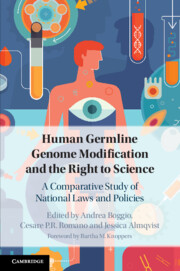 Human Germline Genome Modification and the Right to Science
Human Germline Genome Modification and the Right to Science from Part III - Asia
Published online by Cambridge University Press: 15 November 2019
In Singapore, genome editing techniques may be applied in research but not for therapeutic (or clinical) purposes. Broadly speaking, the legal, regulatory and ethical provisions that apply to genome editing are drawn from five (at times overlapping) regulatory regimes: (i) research involving human embryos and stem cells; (ii) research involving assisted reproduction centers (and assisted reproduction services); (iii) research involving non-human animals; (iv) human biomedical research other than clinical trials; and (v) clinical trials. A human embryo may be created solely for the purposes of research (to study a genome editing technique, for instance), provided certain conditions are met and requisite approvals are obtained. Any such research should not extend beyond fourteen days from the time that the embryo was created. These requirements apply mutatis mutandis to the use of genome editing techniques to modify the genome of human oocytes and embryos. Owing to a moratorium that has been imposed, human germline genetic modification is not allowed in the clinical setting. However, it is less clear if such procedures could be applied in a clinical trial. This chapter provides an analysis of the regulatory framework and its application, as well as how it is expected to change in the foreseeable future.
To save this book to your Kindle, first ensure no-reply@cambridge.org is added to your Approved Personal Document E-mail List under your Personal Document Settings on the Manage Your Content and Devices page of your Amazon account. Then enter the ‘name’ part of your Kindle email address below. Find out more about saving to your Kindle.
Note you can select to save to either the @free.kindle.com or @kindle.com variations. ‘@free.kindle.com’ emails are free but can only be saved to your device when it is connected to wi-fi. ‘@kindle.com’ emails can be delivered even when you are not connected to wi-fi, but note that service fees apply.
Find out more about the Kindle Personal Document Service.
To save content items to your account, please confirm that you agree to abide by our usage policies. If this is the first time you use this feature, you will be asked to authorise Cambridge Core to connect with your account. Find out more about saving content to Dropbox.
To save content items to your account, please confirm that you agree to abide by our usage policies. If this is the first time you use this feature, you will be asked to authorise Cambridge Core to connect with your account. Find out more about saving content to Google Drive.